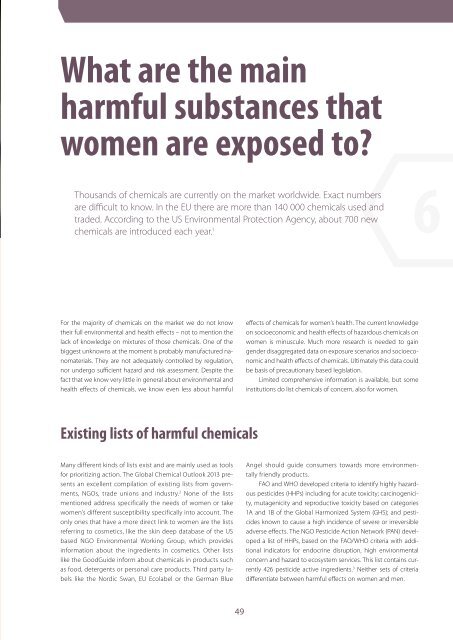Women and Chemicals
1ToENNR
1ToENNR
Create successful ePaper yourself
Turn your PDF publications into a flip-book with our unique Google optimized e-Paper software.
What are the main<br />
harmful substances that<br />
women are exposed to?<br />
Thous<strong>and</strong>s of chemicals are currently on the market worldwide. Exact numbers<br />
are difficult to know. In the EU there are more than 140 000 chemicals used <strong>and</strong><br />
traded. According to the US Environmental Protection Agency, about 700 new<br />
chemicals are introduced each year. 1<br />
6<br />
For the majority of chemicals on the market we do not know<br />
their full environmental <strong>and</strong> health effects – not to mention the<br />
lack of knowledge on mixtures of those chemicals. One of the<br />
biggest unknowns at the moment is probably manufactured nanomaterials.<br />
They are not adequately controlled by regulation,<br />
nor undergo sufficient hazard <strong>and</strong> risk assessment. Despite the<br />
fact that we know very little in general about environmental <strong>and</strong><br />
health effects of chemicals, we know even less about harmful<br />
effects of chemicals for women’s health. The current knowledge<br />
on socioeconomic <strong>and</strong> health effects of hazardous chemicals on<br />
women is minuscule. Much more research is needed to gain<br />
gender disaggregated data on exposure scenarios <strong>and</strong> socioeconomic<br />
<strong>and</strong> health effects of chemicals. Ultimately this data could<br />
be basis of precautionary based legislation.<br />
Limited comprehensive information is available, but some<br />
institutions do list chemicals of concern, also for women.<br />
Existing lists of harmful chemicals<br />
Many different kinds of lists exist <strong>and</strong> are mainly used as tools<br />
for prioritizing action. The Global Chemical Outlook 2013 presents<br />
an excellent compilation of existing lists from governments,<br />
NGOs, trade unions <strong>and</strong> industry. 2 None of the lists<br />
mentioned address specifically the needs of women or take<br />
women’s different susceptibility specifically into account. The<br />
only ones that have a more direct link to women are the lists<br />
referring to cosmetics, like the skin deep database of the US<br />
based NGO Environmental Working Group, which provides<br />
information about the ingredients in cosmetics. Other lists<br />
like the GoodGuide inform about chemicals in products such<br />
as food, detergents or personal care products. Third party labels<br />
like the Nordic Swan, EU Ecolabel or the German Blue<br />
Angel should guide consumers towards more environmentally<br />
friendly products.<br />
FAO <strong>and</strong> WHO developed criteria to identify highly hazardous<br />
pesticides (HHPs) including for acute toxicity; carcinogenicity,<br />
mutagenicity <strong>and</strong> reproductive toxicity based on categories<br />
1A <strong>and</strong> 1B of the Global Harmonized System (GHS); <strong>and</strong> pesticides<br />
known to cause a high incidence of severe or irreversible<br />
adverse effects. The NGO Pesticide Action Network (PAN) developed<br />
a list of HHPs, based on the FAO/WHO criteria with additional<br />
indicators for endocrine disruption, high environmental<br />
concern <strong>and</strong> hazard to ecosystem services. This list contains currently<br />
426 pesticide active ingredients. 3 Neither sets of criteria<br />
differentiate between harmful effects on women <strong>and</strong> men.<br />
49


